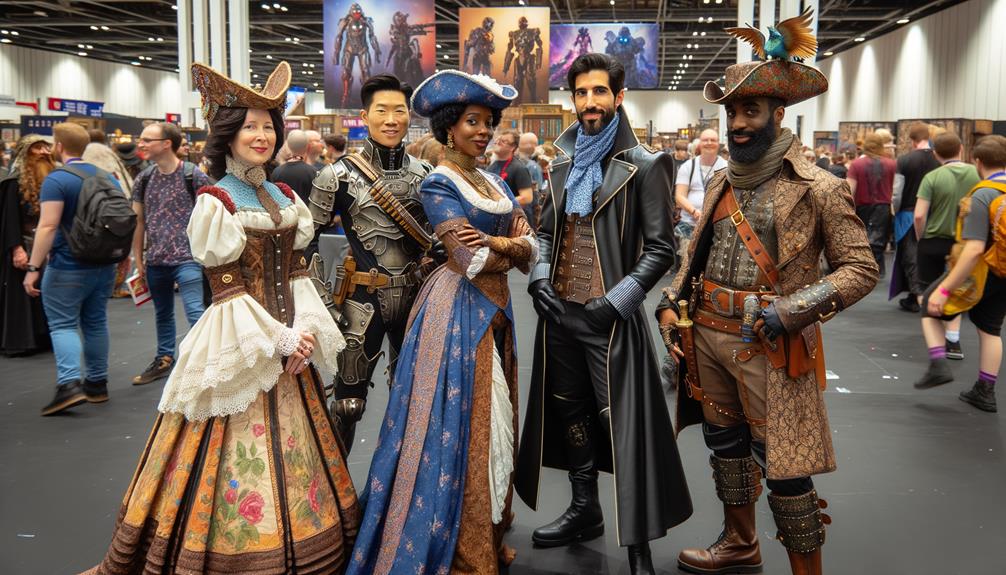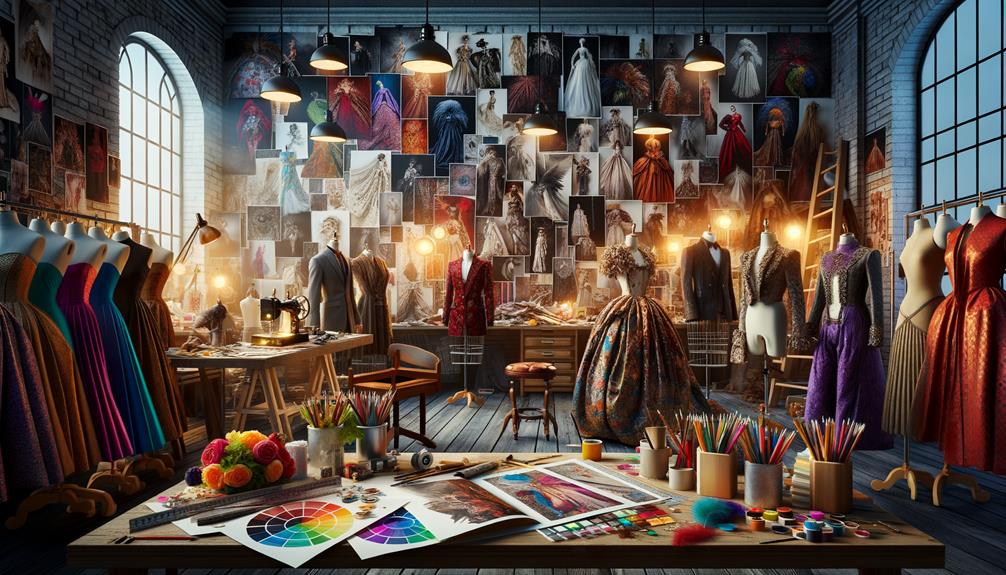When I work with directors, I make sure the costumes align perfectly with the narrative and aesthetic of the production. I listen to their vision and use verbal cues and visual references to bring abstract concepts to life as tangible garments. To get it right, I delve deep into script analysis and research to capture each character's essence. During fittings, I ensure every stitch enhances the actor's portrayal while coordinating with other departments to create a cohesive look. Trust and open communication are vital, often transforming simple fabrics into crucial storytelling elements. There's an art to every seam and detail, enriching the story beyond the surface.
Understanding the Director's Vision
From our initial meeting, I make it a priority to grasp the director's vision, ensuring that the costumes perfectly align with the narrative and aesthetic of the production. As a costume designer, I immerse myself in the director's world, observing their nuances and listening carefully to their ideas. This initial exchange is where I discern the emotional tone and thematic undercurrents that shape my designs. I find it exhilarating to translate abstract concepts into tangible garments that reflect the director's creative vision.
I take note of the director's verbal cues and visual references, which serve as a guide for my design process. For instance, when a director describes a character's journey as 'a descent into chaos,' I envision fabrics that fray and colors that darken progressively. These insights help me create costumes that aren't just clothes but storytelling elements that enhance the narrative.
Our collaboration is a dynamic exchange of ideas where creativity thrives. The director's vision becomes the guiding force behind every stitch and seam. As a costume designer, this alignment ensures that the costumes not only complement but also enrich the storytelling, making the production a cohesive, immersive experience.
Script Analysis and Research
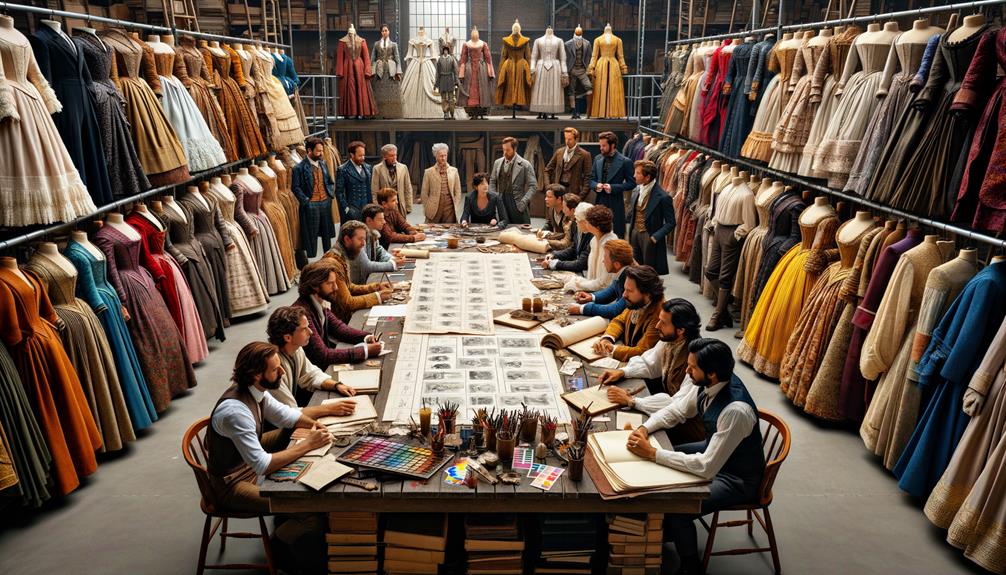
As I delve into the script, I meticulously analyze each scene to uncover the layers of character development and narrative arcs. My goal as a costume designer is to transform these written words into visual stories that resonate with authenticity and creativity. Every line of dialogue and stage direction offers clues about the characters' evolution, their socio-economic backgrounds, and emotional states.
I conduct thorough research, exploring historical periods, cultural contexts, and fashion trends relevant to the script. This isn't just about clothing; it's about capturing the essence of the era and the essence of each character. For instance, a protagonist's journey from despair to triumph can be subtly mirrored through evolving costume choices, reflecting their internal transformation.
Collaboration is crucial in this process. I work closely with the director, production designers, and even actors to ensure that my interpretations align with the broader vision. Using mood boards, fabric swatches, and sketches, I create a visual language that speaks volumes even before a single word is uttered on screen. In this way, costume designers become integral storytellers, weaving threads of narrative through every stitch and seam.
Designing Character Wardrobes
Designing character wardrobes requires a delicate balance of creativity and intention, ensuring each garment reflects the narrative's depth and the character's journey. When I delve into the process, I immerse myself in the script, absorbing the subtleties of each character. Every decision, from fabric choice to color palette, is a meticulous exploration of the character's inner world and external circumstances.
In collaboration with directors, I consider how each costume can visually narrate the story. For instance, a protagonist's transformation might be subtly indicated through evolving wardrobe choices – shifts in fabric texture or color can symbolize growth or turmoil. I'm mindful of how costumes interact with the setting and cinematography, ensuring they enhance rather than overshadow the narrative.
Innovation thrives in the details. A simple accessory can become a pivotal element, adding layers to a character's persona. I constantly push boundaries, blending historical references with modern twists to create timeless, yet contemporary looks. This fusion of old and new breathes life into the wardrobe, making it both relatable and extraordinary.
Ultimately, a well-designed costume doesn't just dress a character; it embodies their essence, making their journey tangible and unforgettable.
Fitting and Adjustments
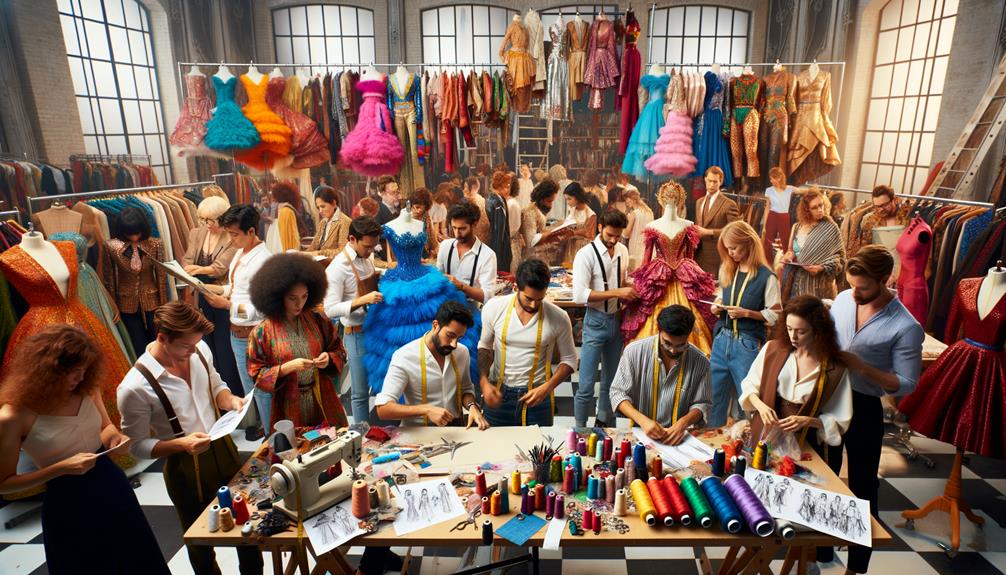
During fittings, I observe the costume designer meticulously tailoring each piece to fit the character perfectly, ensuring the actor looks and feels confident. Real-time adjustments are crucial, and it's fascinating to see how minor tweaks can dramatically alter the overall look. On-set, these alterations continue, adapting to any last-minute changes in the director's vision.
Tailoring for Character Fit
Fittings are the essence of costume design, where every stitch and adjustment brings fabric to life as a character's extension. As a costume designer, I delve into the subtleties of fabric, texture, and silhouette, ensuring each piece aligns with the director's vision and the character's essence.
To bring characters to life, we focus on several key elements during fittings:
- Silhouette Accuracy: Each garment must reflect the character's body shape and movement, enhancing their personality and role.
- Comfort and Mobility: Guaranteeing actors can perform naturally, the fit must be unobtrusive yet supportive.
- Fabric Choice: The weight, texture, and drape of the fabric are pivotal, adding to the authenticity of the costume.
- Detailed Adjustments: Draping, pinning, and padding techniques create a three-dimensional shape that complements the actor's physique.
Every fitting session is a blend of artistry and precision, where we, as costume designers, collaborate closely with directors. It's about making those minute tweaks and adjustments to confirm that costumes not only fit perfectly but also resonate with the character's identity and journey. This meticulous process is where the magic happens, transforming mere clothing into powerful storytelling tools.
On-Set Alterations
On set, the urgency of last-minute costume alterations highlights the dynamic collaboration between the costume designer and the director. In these moments, creativity and practicality merge. I've observed how a costume designer meticulously takes measurements during fittings, noting every detail to ensure a flawless fit. However, the unpredictability of filming schedules often demands quick, on-the-fly adjustments.
Imagine an actor stepping into a scene, and suddenly the director realizes the costume needs to convey a different nuance. The costume designer must then spring into action, making swift alterations, transforming the garment to be camera-ready in mere minutes. This ability to adapt showcases not just skill, but an intimate understanding of the director's vision.
Effective communication is vital. A whispered instruction from the director can lead to a flurry of needle and thread, as the costume designer refines the costume to align more closely with the character's evolving narrative. It's a delicate balance of precision and creativity, where every stitch brings the vision to life. In these moments, the true artistry of costume design is revealed, ensuring each character steps into the spotlight perfectly attired.
Coordination With Other Departments
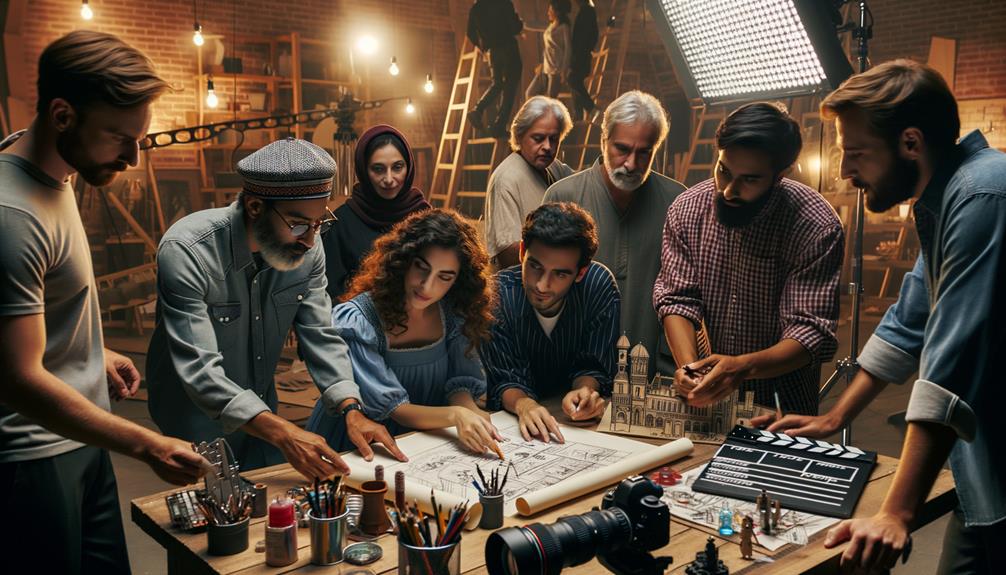
When working with other departments, it's crucial to ensure everyone is on the same page. I've found that sharing resources and using digital platforms can really streamline our collaborative efforts. This approach saves time and helps create a cohesive production environment.
Seamless Team Communication
Effective collaboration between costume designers and various departments is crucial for a seamless and unified production process. As a costume designer, I recognize the importance of working closely with the production designer to ensure our visions align. This partnership is vital because it enables us to create a cohesive aesthetic that enhances the story's authenticity and visual impact.
Smooth communication is the foundation of our creative synergy. To maintain this, we rely on several key practices:
- Regular Check-Ins: Frequent meetings with the production designer and other department heads keep everyone on the same page. These meetings are essential for discussing updates, solving problems, and verifying that our designs complement one another.
- Shared Visual Cues: Using mood boards and concept art helps us visualize and agree upon the overall look. This practice minimizes misunderstandings and streamlines decision-making.
- Collaborative Tools: Digital platforms like shared documents and project management software facilitate instant feedback and efficient information sharing across departments.
- Open Exchange: Encouraging an environment where ideas can be freely exchanged fosters innovation and allows us to adapt quickly to any changes.
Resource Sharing Strategies
Sharing resources efficiently with other departments is crucial to ensure we have what we need without unnecessary delays. As a designer, I believe coordination with other departments is vital to our collective success. We exchange fabric swatches with the lighting team to verify colors appear well on screen, and we share sketches with the set designers to harmonize aesthetics. This collaboration not only saves time but also creates a seamless visual narrative.
Digital platforms have transformed our workflow. Cloud-based storage allows us to access and update costume designs in real-time, keeping everyone on the same page. I often upload costume blueprints so the production team can visualize how they integrate with the overall set design. This transparency eliminates misunderstandings and sparks creative collaboration.
Regular inter-departmental meetings are also vital. These sessions foster brainstorming, where ideas from various perspectives come together. For instance, working with the props department can inspire innovative costume accessories, enhancing character authenticity.
Ultimately, open communication and technology integration are key. By utilizing these resource sharing strategies, we not only streamline processes but also enhance the production's artistic integrity.
Case Studies of Successful Collaborations
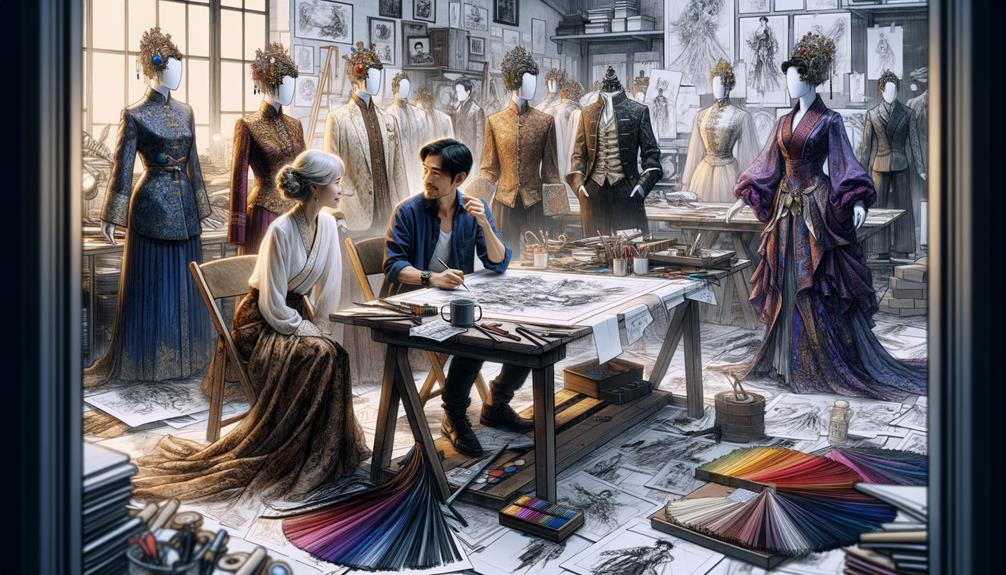
In the live talk series "The Dark Candy," director Steven Bernstein and costume designer Molly Maginnis shared insights into their collaboration on "Last Call," highlighting the importance of trust and communication in forging a film's cohesive visual style. Their work demonstrated how costume design can become a crucial narrative tool when the director and costume designer are on the same page.
During their discussion, they emphasized several key strategies for successful collaboration:
- Understanding the Vision: Molly grasped Steven's ideas and translated them into evocative visual elements that defined both characters and story.
- Creative Problem-Solving: With a tight budget for "Last Call," Molly found innovative ways to achieve a high-quality look, maintaining the film's aesthetic integrity.
- Trust and Open Communication: Their partnership thrived on mutual trust and open dialogue, ensuring the costume design was cohesive and believable.
- Character Development: Through close collaboration, they brought characters to life, with costumes reflecting the nuanced personalities envisioned by Steven.
Their collaboration on "Last Call" serves as a prime example of how effective partnerships between costume designers and directors can elevate a film's visual storytelling, making characters and narrative resonate more profoundly.
Frequently Asked Questions
Who Do Costume Designers Collaborate With?
I work closely with directors, producers, writers, and actors to create a visually stunning representation of the story. My team consists of costume supervisors, design assistants, and specialized artists. Together, we ensure every detail aligns with the production's narrative and vision.
How Do Set Designers and Directors Work Together?
How do set designers and directors create magic together? I observe their synergy, where the director's vision merges with the set designer's creative flair. Through ongoing collaboration and shared objectives, they bring imaginative worlds to life, innovating every step of the way.
How Does a Costume Designer Work With Other People?
As a costume designer, I work closely with makeup artists, set designers, and lighting technicians to create a cohesive look that supports the narrative and enhances the audience's experience. We review our ideas to ensure we're on the same page, pushing creative boundaries while staying true to the story.
What Does a Costume Director Do?
As a costume director, I transform actors into their characters, bringing the story to life. I'm responsible for designing costumes, managing budgets, and ensuring every detail reflects the story's essence. By merging creativity with practicality, I create unforgettable visuals that captivate audiences.



